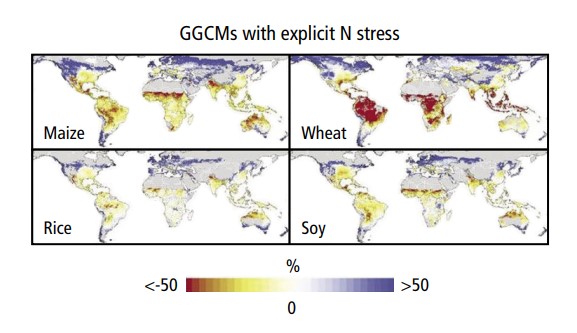
Misleading: Plants require CO2, water, and other nutrients to grow. Although CO2 emissions can increase plant growth in some regions, they also increase heat stress, water stress, and pest prevalence.

RECLAMACION: CO2 is a plant nutrient...it’s not a pollutant that threatens human civilization as has been ridiculously claimed by global warming doomsday pushers. CO2 actually increases plant yields, accelerates "re-greening" and improves reforestation of the planet. If CO2 was so terrible for the planet, then installing a CO2 generator in a greenhouse would kill the plants.
SUMMARY
The claim that CO2 is a plant nutrient and not a pollutant appeared in an article published by Natural News in June 2013, and has gone viral in 2020 with over 1.6 million shares on Facebook over the past three months. This claim uses flawed reasoning to argue that elevated levels of CO2 are not bad for the planet because it doesn’t kill plants in a greenhouse.
Although CO2 can increase plant growth in a greenhouse, this effect does not necessarily apply to more complex natural environments where the benefits of CO2 can be outweighed by nutrient limitation and negative climate impacts, such as increasing water stress, heat stress, and the prevalence of pests and pathogens. In order to assess the overall impact of CO2 on the planet, all known effects of CO2 on land ecosystems and human societies should be evaluated, instead of focusing on just one aspect as this claim does[1,2,3,4].
Vegetation has absorbed some of the CO2 emitted by human activities and converted it into leaf biomass, particularly in southeast North America, the northern Amazon, Europe, Central Africa, and Southeast Asia, as seen in the figure below[1].
Figure- Increased CO2 emissions have increased plant growth (leaf area index (LAI)) around the world. From Zhu et al. (2016)[1].
But in addition to CO2, plants require water and other nutrients to grow. Scientific studies show the effects of CO2 on plant growth depend on the availability of other nutrients, such as phosphorus and nitrogen, as seen in the figure below[2,5,6].
Figure- Under high concentrations of CO2 (RCP8.5), crop models (GGCMs) predict that nitrogen (N) stress will reduce crop yields (%) in 2070-2099 relative to yields from 1980 to 2010. From Mbow et al. (2019)[2].
CO2 emissions are also predicted to produce less nutritional crops and reduce crop yields over time[2]. “While increased CO2 is projected to be beneficial for crop productivity at lower temperature increases, it is projected to lower nutritional quality,” according to the IPCC report on food security[2]. Because CO2 emissions contribute to global warming, crop yields are predicted to decline with increasing temperatures due to increases in heat stress, water stress, and the persistence of pests and pathogens, as seen in the figure below[3,4].
Figure- A meta-analysis of 56 studies predicts that crop yields for maize, rice, wheat, and soy decline as temperatures increase relative to local baseline growing-season temperatures. From Moore et al. (2017)[4].
More broadly, increases in plant growth due to increased CO2 emissions may be offset by negative effects on land ecosystems due to rising global temperatures, prolonged droughts, and increases in intense rainstorms[2,6]. In tropical and semi-arid regions, even moderate increases in temperature could lead to drier conditions that induce water stress, disrupt plant reproduction, and reduce crop yields[7]. Nitrogen stress due to soil degradation is predicted to result in even greater declines in crop yields in the tropics[2].
Additionally, the effects of climate change are not limited to terrestrial plant productivity. Impacts on weather extremes, coastal infrastructure, human health, and marine ecosystems—among other things—are also relevant to the question of whether CO2 is a «pollutant that threatens human civilization», in the article’s words.
SCIENTISTS’ FEEDBACK
Pierre Friedlingstein, Professor, University of Exeter:
[Comment from a previous evaluation of a similar claim.]
This is the usual misleading argument that if CO2 is good for plants, it cannot be bad for the climate. CO2 is needed for plant growth (along with water, nutrients, and energy from the sun)—but it does not change the fact that CO2 is a greenhouse gas. It increases the radiative forcing of the planet and leads to warming, as observed over the last century[6].
Frances Moore, Assistant Professor, University of California Davis:
[Comment from a previous evaluation of a similar claim.]
In a meta-analysis of over 1,000 studies of the effects of climate change on agriculture, we find that, while CO2 is beneficial for crops, this effect rapidly decreases with increasing concentrations[4]. The net effects of climate change on agriculture, including both the benefits of CO2 fertilization and the negative effects of warming, is negative for almost all regions. The effects of CO2 emissions on agriculture cost approximately $8.5 per ton, even accounting for the positive effects of CO2 fertilization.
Sara Vicca, Postdoctoral research fellow, University of Antwerp:
[Comment from a previous evaluation of a similar claim.]
Plants don’t only need CO2 and water, but also nutrients like nitrogen and phosphorus. If the latter are not sufficiently available, plants may not respond to elevated CO2 at all[5,6]. Moreover, climatic changes (and particularly extreme events) are an important threat to ecosystems and to the land carbon sink[2,3,7,8].
Alexis Berg, Associate Research Scholar, Princeton University:
[Comment from a previous evaluation of a similar claim.]
Yes, we are seeing an increase in vegetation around the world, with satellites showing up to 50% of the land surface greening over the last 30 years, most of it being indeed attributed to increased atmospheric CO2[1]. This is not a surprise. This vegetation increase is consistent with the fact that we know that about a quarter of our CO2 emissions is being taken up by the land biosphere (another quarter going into the oceans, and the remainder staying in the atmosphere). This greening is taken into account in climate models. The real question is how long this greening is going to go on (there are already indications that it is slowing down), as we expect that as climate warms further, adverse impacts on ecosystems may start to offset the positive impact of increased atmospheric CO2—particularly in places where regional climate is moving away from the “comfort zone” of current ecosystems.
Amber Kerr, Researcher, Agricultural Sustainability Institute, University of California, Davis:
[Comment from a previous evaluation of a similar claim.]
CO2 is not a pollutant in the sense of being acutely toxic to life, but this framing is highly misleading. Water is also non-toxic and essential to life on Earth, but too much water in the wrong places can be devastating.
REFERENCES
- 1- Zhu et al. (2016) Greening of the Earth and its drivers. Nature Climate Change.
- 2- Mbow et al. (2019) IP Food Security. In: Climate Change and Land: an IPCC special report on climate change, desertification, land degradation, sustainable land management, food security, and greenhouse gas fluxes in terrestrial ecosystems. IPCC report.
- 3- Rosenzweig et al. (2014). Assessing agricultural risks of climate change in the 21st century in a global gridded crop model intercomparison. PNAS.
- 4- Moore et al. (2017) New science of climate change impacts on agriculture implies higher social cost of carbon. Nature.
- 5- Zhang et al. (2014) Nitrogen and phosphorous limitations significantly reduce future allowable CO2 emissions, Geophysical Research Letters.
- 6- De Graaff et al. (2006) Interactions between plant growth and soil nutrient cycling under elevated CO2: a meta-analysis. Global Change Biology.
- 7- Shakun et al. (2012) Global warming preceded by increasing carbon dioxide concentrations during the last deglaciation. Nature.
- 8- Tubiello et al. (2007). Crop and pasture response to climate change. PNAS.





